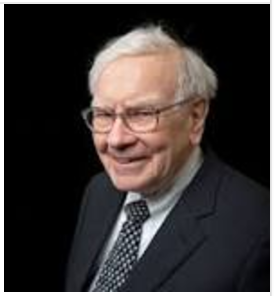An amazing lesson from Buffett on his cake day
Courtesy of Joshua M Brown
 Nick Murray says “The ability to distinguish between volatility and loss is the first casualty of a bear market.”
Nick Murray says “The ability to distinguish between volatility and loss is the first casualty of a bear market.”
I turned to one of my favorite passages of his masterpiece Simple Wealth, Inevitable Wealth this morning as turmoil from overseas and the commodity markets made its way through the headlines. Nick relays a great anecdote about how much money one investor personally “lost” during the last Russian Ruble crisis in the summer of 1998…
$6,200,000,000
Yes, that’s right, it’s six billion two hundred million dollars. A very large sum of money, wouldn’t you say? Now what, you ask, does it represent?
It is roughly how much Warren Buffett’s personal shareholdings in his Berkshire Hathaway, Inc. declined in value between July 17 and August 31, 1998. And now for the six billion dollar question. During those forty-five days, how much money did Warren Buffett lose in the stock market?
The answer is, of course, that he didn’t lose anything. Why? That’s simple: he didn’t sell.
In July and August of 1998, I was doing time at a brokerage firm on Long Island as a summer intern. The brokers were panicking and the partners began yelling at them to get off margin and help maintain order in the Asia Pacific technology stocks in which the firm made markets. It wasn’t working, from what I could surmise. The simultaneous meltdown of several Far East currencies and then the toppling of the Ruble proved too much for US markets and eventually the contagion found its way here.
People forget that, in the midst of the massive late 1990’s bull market, we had this two-month bear market episode in which the S&P 500 dropped by a quick 25 percent. The giant Nobel laureate-run hedge fund, Long Term Capital, imploded as a result and Greenspan was forced to slash rates overnight while the New York Fed arranged a Wall Street-subsidized bailout. Things got back to normal by the end of the fall, but, for a minute there, the panic was palpable and it eventually slammed everyone.
I bring this up because there are some parallels between then and now (along with some highly notable differences, as always). The drama surrounding the Russian economy, currency and stock market – along with the dual crash in crude oil – has shaken confidence around the world. Volatility has spread throughout the US stock and bond markets in recent days. History tells us it can get significantly worse really quickly before the storm passes – a la the currency crises of the summer of 1998. At the end of the day, we just don’t know.
 Warren Buffett didn’t change his plans or blast a great big hole in his portfolio that summer. He did not turn temporary declines into permanent losses. Instead, he stuck to his investment strategy while so many others lost their grip.
Warren Buffett didn’t change his plans or blast a great big hole in his portfolio that summer. He did not turn temporary declines into permanent losses. Instead, he stuck to his investment strategy while so many others lost their grip.
Buffett didn’t have any information about the future then just as we don’t today. But what he did have, according to Murray and all of his biographers, was an incredibly even-keeled temperament. It is Buffett’s temperament and not his analytical skill that allows him to ride out episodes like this. But more than that, it is Buffett’s ability to distinguish between volatility and risk.
One of the things that probably helps him do that is his own experience with difficult markets. Murray points out us that Buffett had been through the crash of October 1987 and had only “lost” $347,000,000 that day. He didn’t sell during that crash either. This is the precise reason why, 11 years later, Buffett was even in a position to have a temporary drawdown of $6.2 billion.
The smile never left his face, and it’s easy to see why. Berkshire Hathaway closed on October 19, 1987 at $3,170 a share. On August 31st, 1998, it closed at $60,500. And just the other day, I saw it at $150,000.
In case you’re keeping score, Berkshire’s A shares go for $218,000 as I write. Buffett’s biggest risk would have been allowing the momentary madness of a market panic to divert him from the bigger picture.
Source:
Simple Wealth, Inevitable Wealth (NickMurray.com)
***
Happy birthday to the G.O.A.T. – one of the most fortunate things in my life is the fact that I’d adopted Buffett and Munger as two of my investing idols early enough for their teachings to have become ingrained in my philosophy.



